fold seats AUDI Q3 2018 Owners Manual
[x] Cancel search | Manufacturer: AUDI, Model Year: 2018, Model line: Q3, Model: AUDI Q3 2018Pages: 230, PDF Size: 57.03 MB
Page 45 of 230
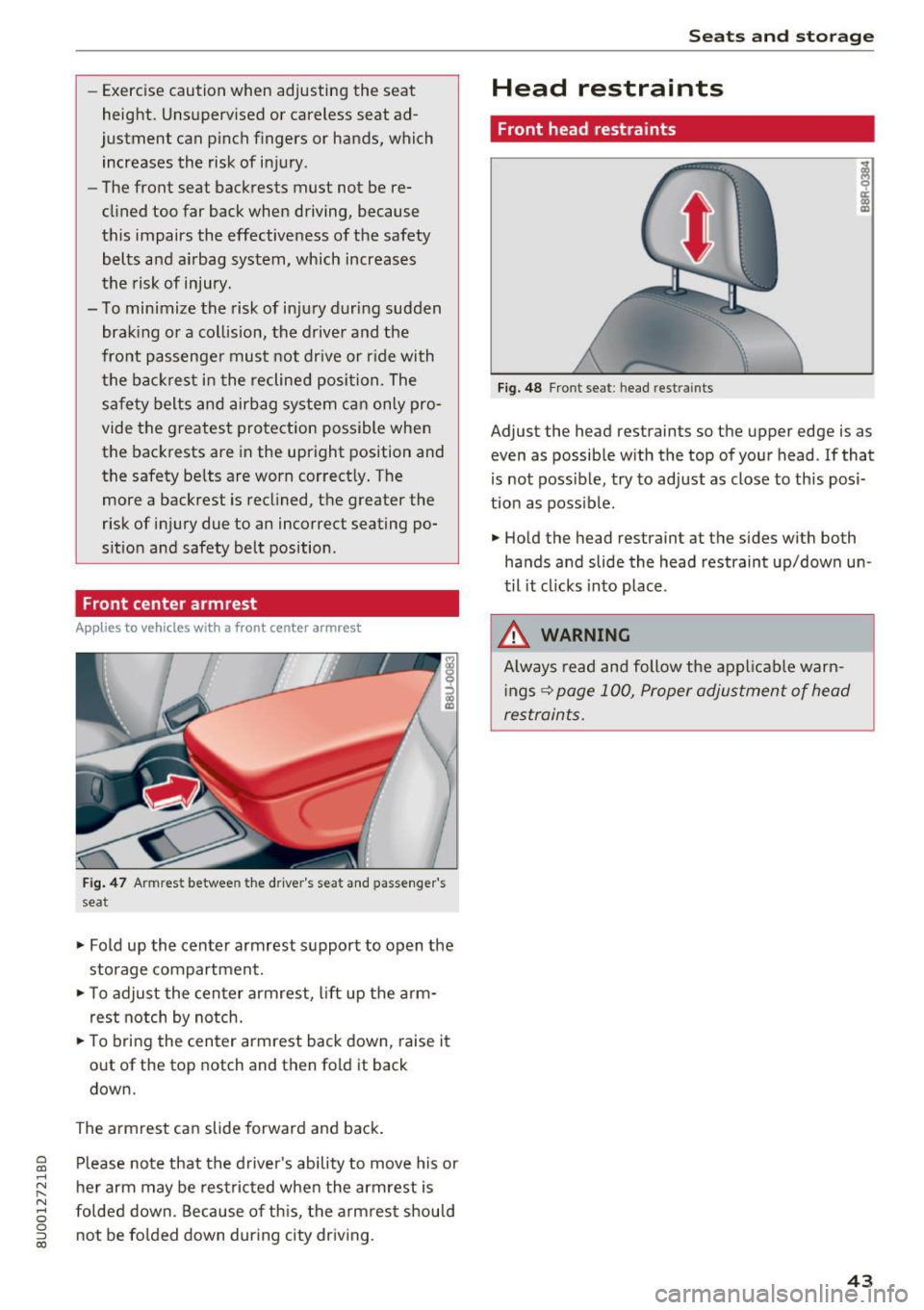
a
co
...... N r--. N .-< 0 0 ::, co
-Exercise caution when adjusting the seat
height. Unsupervised or careless seat ad
justment can pinch fingers or hands, which
increases the risk of injury .
- The front seat backrests must not be re
clined too far back when driving, because
this impairs the effectiveness of the safety
belts and airbag system, which increases
the risk of injury.
- To minimize the risk of injury during sudden
braking or a collision, the driver and the
front passenger must not drive or r ide with
the backrest in the reclined position. The
safety belts and airbag system can only pro
vide the greatest protection possible when
the backrests are in the upright position and
the safety belts are worn correctly. The more a backrest is reclined, the greater the
risk of injury due to an incorrect seating po
sition and safety belt position .
Front center armrest
Applie s to vehicles with a front center armrest
Fig. 47 Armrest between the driver's seat and passenger's
seat
.,. Fold up the center armrest support to open the
storage compartment.
.,. To adjust the center armrest, lift up the arm
rest notch by notch .
.,. To bring the center armrest back down, raise it
out of the top notch and then fold it back
down.
The armrest can slide forward and back. Please note that the driver 's ability to move his or
her arm may be restricted when the armrest is
folded down. Because of this, the armrest should
not be folded down during city driving.
Seats and storage
Head restraints
Front head restraints
Fig. 48 Front seat: head restraints
Adjust the head restraints so the upper edge is as
even as possible with the top of your head . If that
is not possible, try to adjust as close to this posi
tion as poss ible .
.,. Hold the head restraint at the sides with both
hands and slide the head restraint up/down un
til it clicks into place .
_& WARNING
Always read and follow the applicable warn
ings
~ page 100, Proper adjustment of head
restraints.
.
43
Page 48 of 230
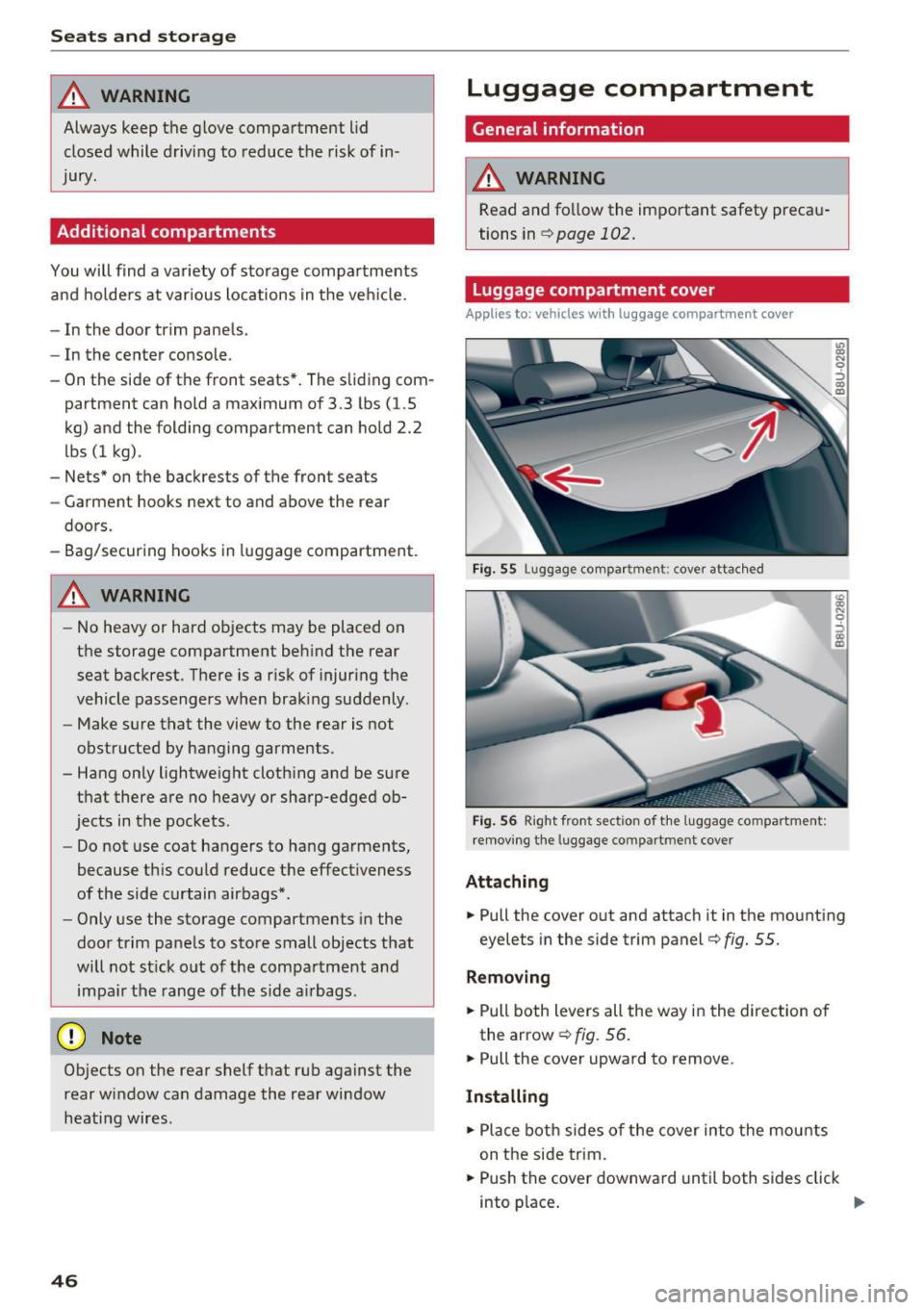
Sea ts and stor age
_&. WARNING
Always keep the glove compartment l id
closed while driv ing to reduce the risk of in
jury.
Additional compartment s
You will find a variety of storage compartments
and holde rs at var ious locations in the veh icle.
- In the door trim panels .
- In the center console .
- On the side of the front seats*. The sliding com-
partment can hold a maximum of 3.3 lbs (1.5
kg) and the folding compartment can hold 2.2
lbs (1 kg).
- Nets* on the backrests of the front seats
- Garment hooks next to and above the rear
doors.
- Bag/securing hooks in luggage compartment.
_&. WARNING
- No heavy or hard objects may be placed on
the storage compartment behind the rear
seat backrest. There is a risk of injur ing the
vehicle passengers when brak ing suddenly .
- Make sure that the view to the rear is not
obstructed by hanging garments .
- Hang only lightweight clothing and be sure that there are no heavy or sharp-edged ob
jects in the pockets .
- Do not use coat hangers to hang garments,
because th is could reduce the effectiveness
of the side curtain airbags* .
- Only use the storage compartments in the
door trim panels to store small objects that
will not st ick o ut of the compartment and
impa ir the range of the side a irbags .
(D Note
Objects on the rear shelf that rub against the
rear window can damage the rear window
heating wires .
46
Luggage compartment
General information
_&. WARNING
Read and follow the important safety precau
tions in ¢page
102.
Luggage compartment cover
Applies to: vehicles with luggage compartment cover
Fig . 55 Lug gage co mpar tmen t: c over attac hed
Fig . 56 Right fron t sec tio n of the luggage co m partment:
remov ing the luggage co mpartm ent cove r
Attaching
-
.. Pull the cover out and attach it in the mounting
eyelets in the side trim panel ¢
fig. 55.
Removing
.. Pull both levers all the way in the direction of
the arrow ¢
fig. 56 .
.. Pull the cover upward to remove .
Installing
.. Place both sides of the cover into the mounts
on the side trim .
.. Push the cover downward until both sides click
into p lace .
Page 49 of 230
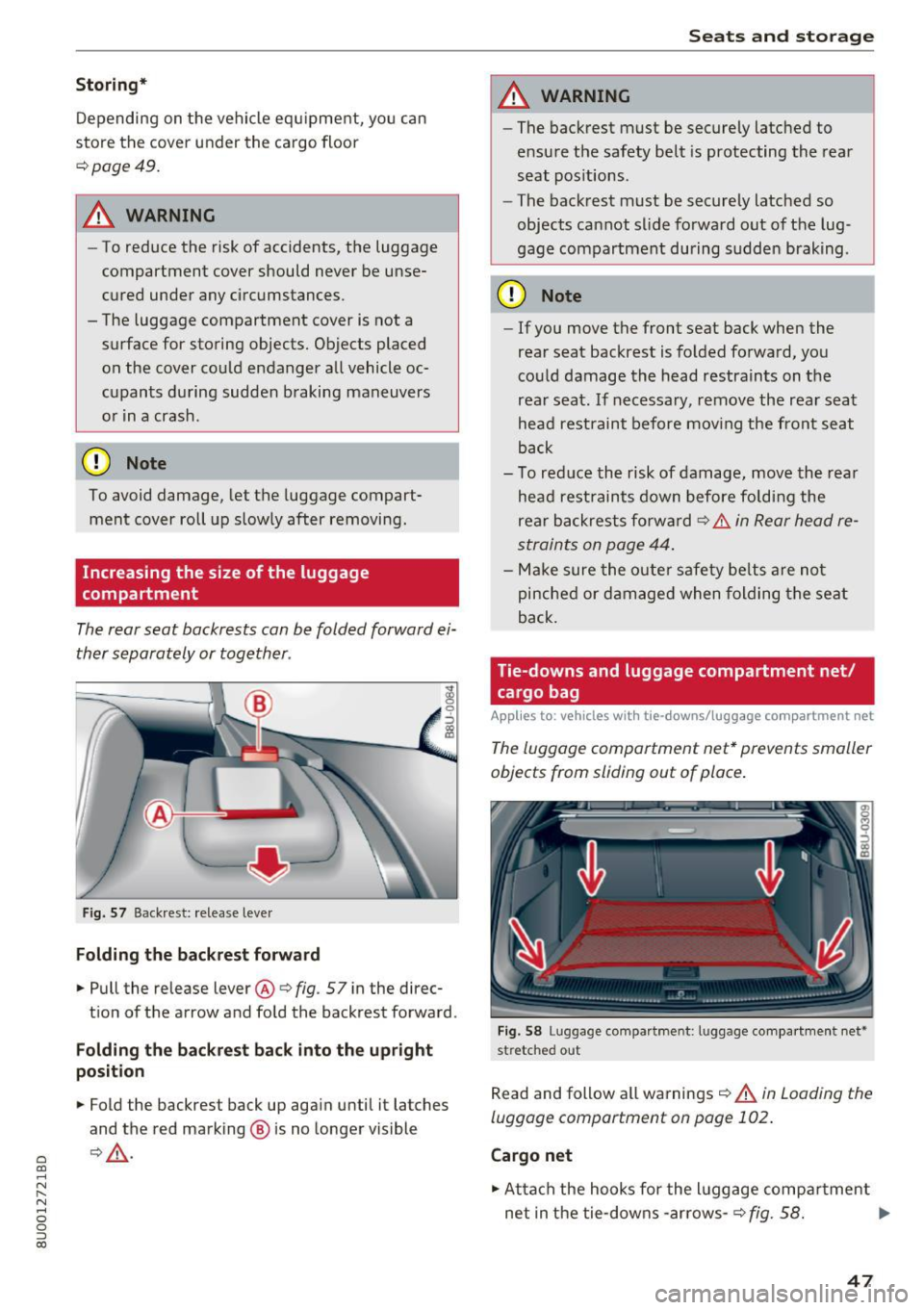
a
co
...... N r--. N .... 0 0 ::, co
Storing* Depending on the vehicle equ ipment, yo u can
store the cover under the cargo floor
Q page49.
.&_ WARNING
- To reduce the risk of accidents, the luggage
compartment cover should never be unse
cured under any circumstances .
- The luggage compartment cover is not a surface for storing objects. Objects placed on the cover co uld endanger a ll vehicle oc
c u pan ts during sudden braking maneuvers
o r in a crash.
CD Note
To avoid damage , let t he luggage compart
ment cover roll up slow ly after removing .
Increasing the size of the luggage
compartment
The rear seat backrests can be folded forward e i
ther s eparately or together .
Fig . 57 Backrest: re lease leve r
Folding the backrest forward
.,. Pull the release lever@Q
fig. 57 in the direc-
t ion of the arrow and fo ld the backrest forward .
Folding the backrest back into the upright
position
.,. Fold the backrest back up aga in until it latches
and the red marking ® is no longe r visible
Q _& .
Seats and storag e
.&_ WARNING
-~
-The backrest must be secure ly latched to
e nsu re the safety belt is protecting the rea r
seat pos itions .
- The bac krest must be securely latched so
objects cannot slide fo rwa rd out of the lug
gage compartment during sudde n braking .
CD Note
-If you move the front seat back when the
rear seat backrest is fo lded fo rwa rd, yo u
could damage the head restraints on the
rear seat . If necessary, remove the rear seat
hea d rest raint before mov ing the front seat
back
- To red uce the risk of damage, move the rea r
hea d res train ts down before f oldi ng the
rea r back res ts fo rw ar d Q
.&. in Rear head re
straint s on page 44.
- Make sure the o uter sa fety be lts are not
pinche d or d am aged when fol din g th e seat
back.
Tie-downs and luggage compartment net /
cargo bag
Applies to : vehicles with tie-downs/luggage compartment net
The luggage compartment net* prevents smaller
objects from sliding out of place .
Fig. 58 Luggage co mpa rt me nt: lu ggage compa rtme nt net •
st retc hed o ut
Read and follow a ll warn ings Q .& in Loading the
luggage compartment on page 102 .
Cargo net
.,. At ta ch the hoo ks for the l uggage compa rtment
net in t he tie -dow ns -ar rows-
Q fig. 58. ..,
47
Page 51 of 230
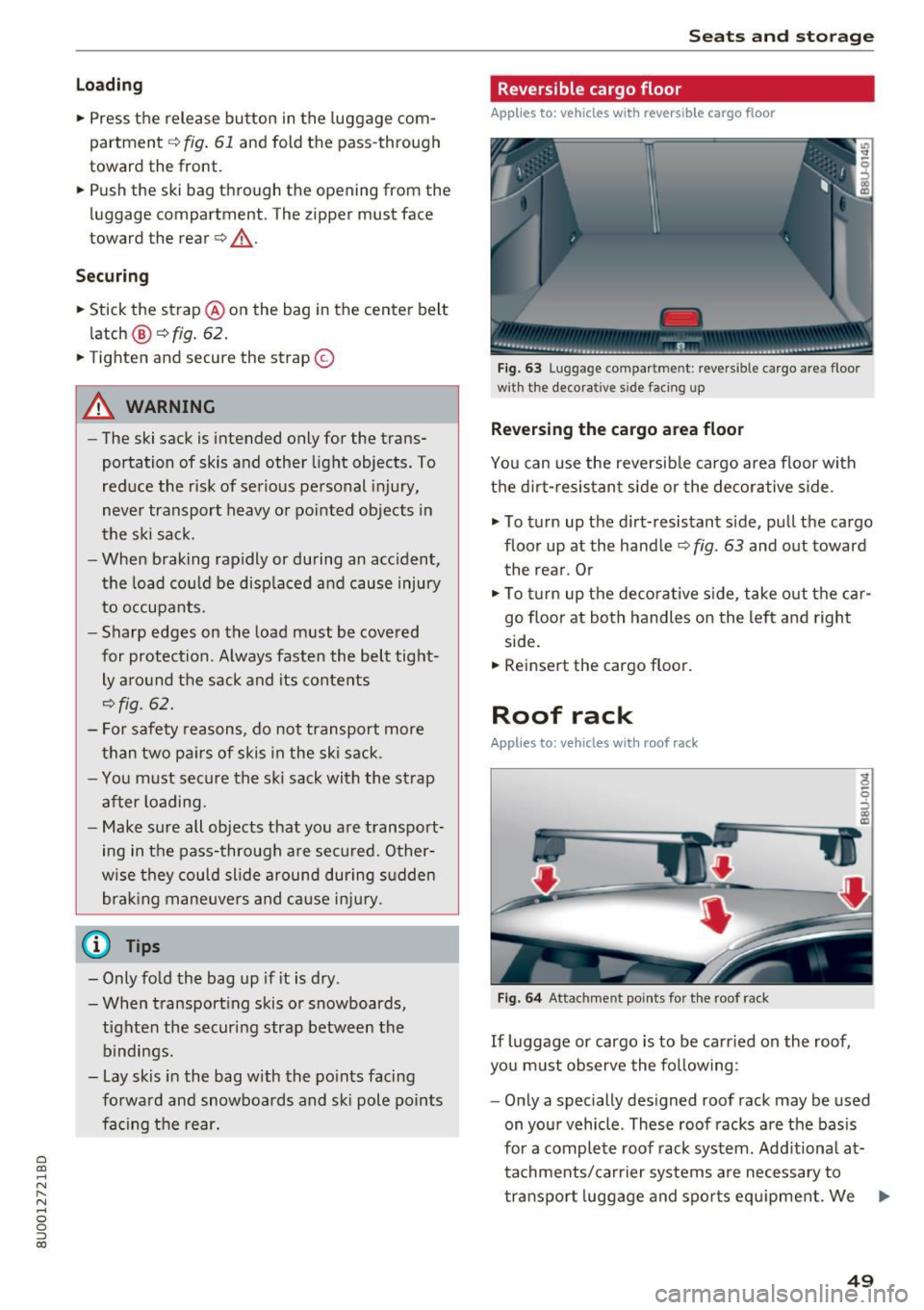
a
co
...... N r--. N .-< 0 0 ::, co
Loading
• Press the release button in the luggage com
partment
c:> fig. 61 and fold the pass-through
toward the front.
• Push the ski bag through the op ening from the
luggage compartment . T he zipper must face
toward the rear
c:> ,& .
Securing
• Stick the strap @on th e bag in the center belt
latch
@ c:> fig. 62.
• Tighten and secure the strap©
A WARNING
-The ski sack is intended only for the trans
portation of skis and other light objects. To
reduce the risk of serious personal injury,
never transport heavy or pointed objects in
the ski sack.
- When braking rapidly or during an accident ,
the load could be displaced and cause injury
to occupants.
- Sharp edges on the load must be covered
for protection. Always fasten the belt tight ly around the sack and its contents
c:>fig . 62.
- For safety reasons, do not transport more
than two pairs of skis in the ski sack .
- You must secure the ski sack with the strap
after loading.
- Make sure all objects that you are transport
ing in the pass-through are secured. Other
wise they could slide around during sudden
braking maneuvers and cause injury .
(D Tips
-Only fold the bag up if it is dry.
- When transporting skis or snowboards, tighten the securing strap between the
bindings.
- Lay skis in the bag with the points facing
forward and snowboards and ski pole points
facing the rear.
-
Seats and storage
Reversible cargo floor
Applies to: vehicles with reversible cargo floor
Fig. 63 Lug gag e compar tmen t: reve rs ibl e ca rgo area floor
w ith the decora tive s ide faci ng up
Reversing the cargo area floor
You can use the reversible cargo area floor with
the dirt-resistant side or the decorative side .
.,. To turn up the dirt-resistant side, pull the cargo
floor up at the handle
c:> fig . 63 and out toward
the rear . Or
.,. To turn up the decorative side , take out the car
go floor at both handles on the left and right
side.
• Reinsert the cargo floor.
Roof rack
Applies to: vehicles with roof rack
Fig. 64 Attac hme nt point s for the roof rack
If luggage or cargo is to be carried on the roof,
you must observe the following :
- Only a specially designed roof rack may be used
on your vehicle . These roof racks are the basis
for a complete roof rack system. Additional at
tachments/carrier systems are necessary to
transport luggage and sports equipment. We ..,.
49
Page 101 of 230
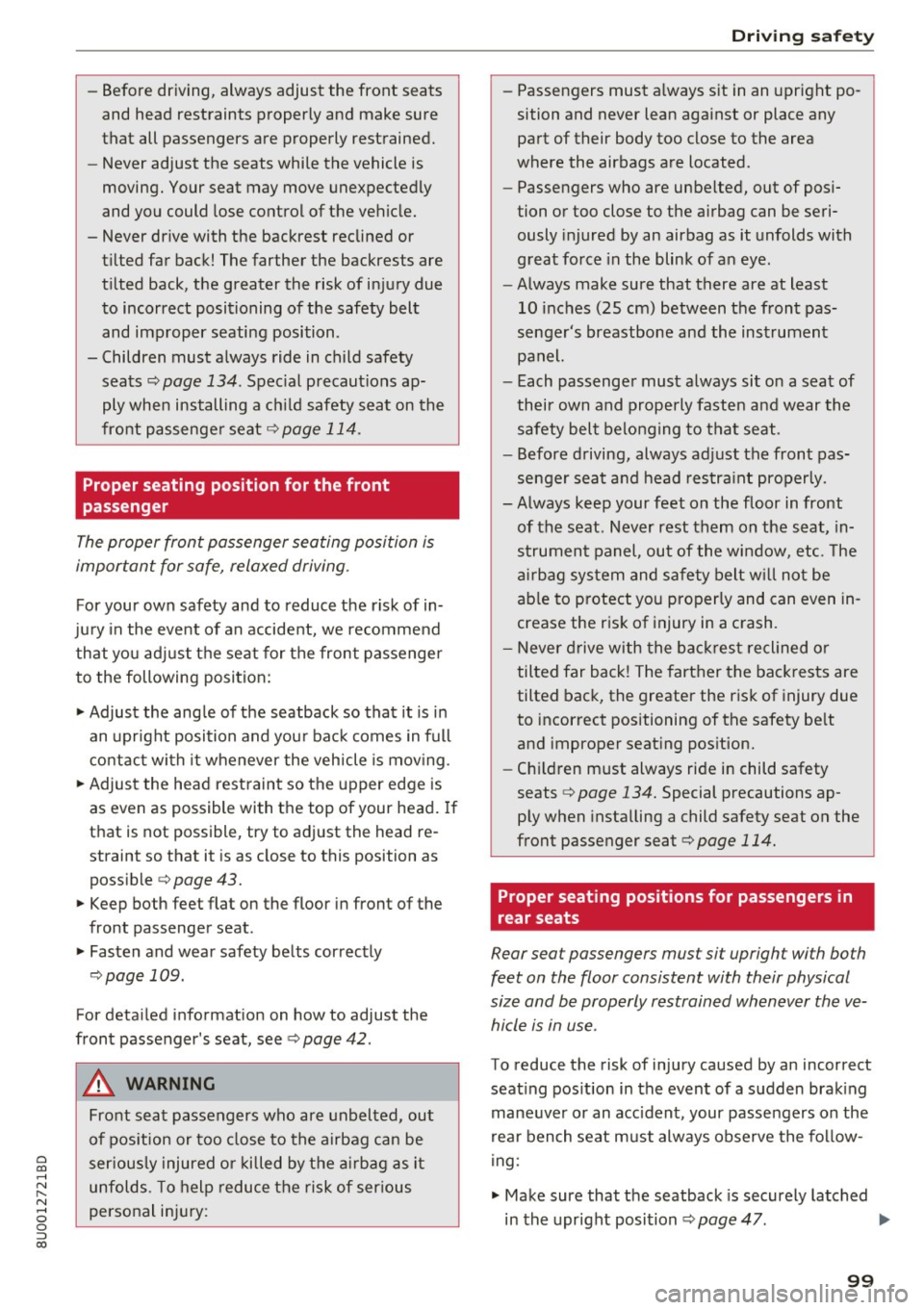
0 co ......
"' ,....
"' ...... 0 0 :::,
00
- Before driving, always adjust the front seats
and head restraints properly and make sure
that all passengers are properly restrained.
- Never adjust the seats while the vehicle is
moving. Your seat may move unexpectedly
and you could lose control of the vehicle.
- Never drive with the backrest reclined or
tilted far back! The farther the backrests are
tilted back, the greater the risk of injury due
to incorrect positioning of the safety belt
and improper seating position .
- Children must always ride in child safety
seats ¢
page 134 . Special precautions ap
ply when installing a chi ld safety seat on the
front passenger seat¢
page 114.
Proper seating position for the front
passenger
The proper front passenger seating position is
important for safe, relaxed driving.
For your own safety and to reduce the risk of in
jury in the event of an accident, we recommend
that you adjust the seat for the front passenger
to the following position:
• Adjust the ang le of the seatback so that it is in
an upright position and your back comes in full
contact with it whenever the vehicle is moving.
• Adjust the head restraint so the upper edge is
as even as possible with the top of your head. If
that is not possible, try to adjust the head re straint so that it is as close to this position as
possible ¢
page 43.
• Keep both feet flat on the floor in front of the
front passenger seat .
• Fasten and wear safety belts correctly
¢ page 109.
For detailed information on how to adjust the
front passenger's seat, see¢
page 42 .
A WARNING
Front seat passengers who are unbelted, out
of pos ition or too close to the airbag can be
ser iously injured or killed by the airbag as it
unfolds . To help reduce the risk of serious
personal injury:
Driving safety
- Passengers must always sit in an upright po
sition and never lean against or place any part of their body too close to the area
where the airbags are located .
- Passengers who are unbelted, out of posi
tion or too close to the airbag can be seri ously injured by an airbag as it unfolds with
great force in the blink of an eye.
- Always make sure that there are at least
10 inches (25 cm) between the front pas
senger's breastbone and the instrument panel.
- Each passenger must always sit on a seat of
their own and properly fasten and wear the
safety belt belonging to that seat.
- Before driving, always adjust the front pas
senger seat and head restraint properly.
- Always keep your feet on the floor in front
of the seat . Never rest them on the seat, in
strument panel, out of the window, etc. The
airbag system and safety belt will not be
able to protect you properly and can even in
crease the risk of injury in a crash.
- Never drive with the backrest reclined or
tilted far back! The farther the backrests are
tilted back, the greater the risk of injury due
to incorrect positioning of the safety belt
and improper seating position.
- Chi ldren must always ride in child safety
seats ¢
page 134. Special precautions ap
ply when installing a child safety seat on the
front passenger seat¢
page 114.
Proper seating positions for passengers in
rear seats
Rear seat passengers must sit uprigh t wi th both
feet on the floor consistent with their physical
size and be properly restrained whenever the ve
hicle is in use .
To reduce the risk of injury caused by an incorrect
seating position in the event of a sudden braking
maneuver or an accident, your passengers on the
rear bench seat must always observe the follow
ing :
• Make sure that the seatback is securely latched
in the upright position¢
page 47. .,.
99
Page 114 of 230
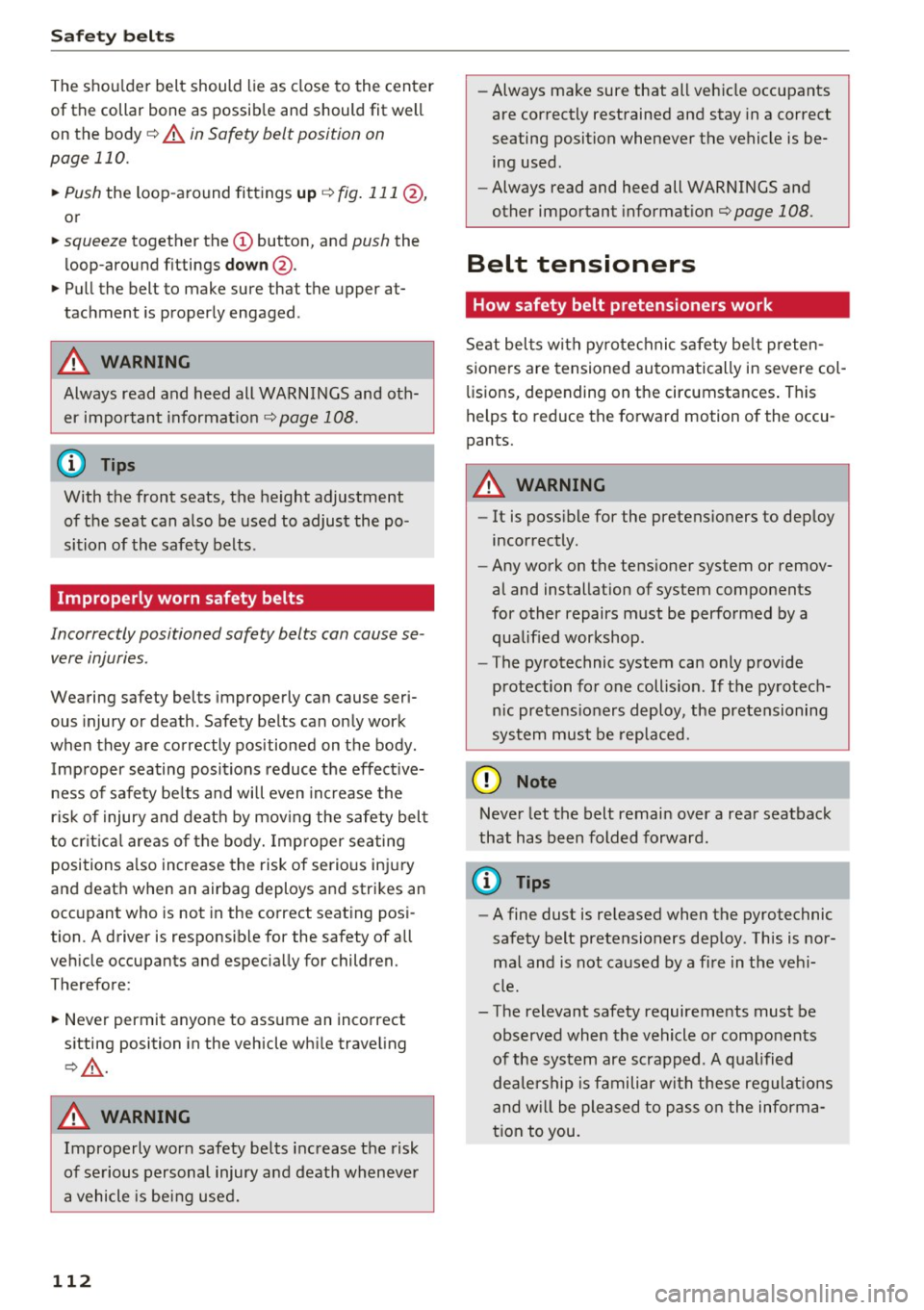
Safety belts
The shou lder belt should lie as close to the center
of th e collar bone as possib le and should fit well
on the body
c::> A in Safety belt position on
page 110.
"' Push
the loop -a round fittings up c::> fig. 111 @ ,
or
"'squeez e together the (D button, and push the
loop-around fittings down@.
"'Pull the belt to m ake sure that the upper at
tachment is properly engaged .
A WARNING
Always read and heed all WARNINGS and oth er important informat ion
c::> page 108.
(D Tips
With the front seats, the height adjustment of the seat can also be used to adjust the po
sition of the safety belts.
Improperly worn safety belts
Incorrectly positioned safety belts can cause se
vere injuries .
Wearing safety belts improperly can cause seri
ous injury or death . Safety belts can only work
when they are correctly positioned on the body.
Improper seating positions reduce the effect ive
ness of safety belts and will even inc rease the
risk of injury and death by mov ing the safety belt
to cr it ica l areas of the body. Improper seating
positions a lso increase the risk of serious injury
and death when an airbag deploys and strikes an
occupant who is not in the correct seating pos i
tion . A drive r is responsible for the safety of all
veh icle occupants and especially for children.
Therefore :
"' Never permit anyon e to assume an incorrect
sitting position in the vehicle while traveling
c>_& .
A WARNING
Improperly worn safety belts increase the risk
of serious personal injury and death whenever
a vehicle is being used.
112
- Always make sure that all vehicle occupants
are correctly restrained and stay in a correct
seating position whenever the vehicle is be
ing used.
- Always read and heed all WARNINGS and
other important informat ion
c::> page 108 .
Belt tensioners
How safety belt pretensioners work
Seat belts with pyrotechnic safety be lt preten
sioners are tensioned automatically in severe col
lisions, depending on the circumstances . This
helps to reduce the forward motion of the occu
pants.
A WARNING
- It is possible for the pretensioners to deploy
incorrectly .
- Any work on the tensioner system or remov
al and installation of system components
for other repairs must be performed by a qualified workshop .
- The pyrotechnic system can only provide
protection for one collision.
If the pyrotech
nic pretens ioners deploy, the pretensioning
system must be replaced.
(D Note
Never let the belt remain over a rear seatback
that has been folded forward.
(D Tips
- A fine dust is released when the pyrotechnic
safety belt pretensioners deploy . This is nor
mal and is not caused by a fire in the veh i
cle.
- The relevant safety requirements must be
observed when the vehicle or components
of the system are scrapped . A qualified
dealership is familiar with these regulations
and will be pleased to pass on the informa
tion to you.
Page 124 of 230

Airbag syste m
damaged, preventing them and the airbag
system from working properly.
- Never place seat covers or rep lacement up
holstery that have not been specifically ap
proved by Audi on the front seats .
- Seat covers can prevent the Advanced Air
bag System from recognizing child re
straints or occupants on the front passenger
seat and prevent the side a irbag in the seat
backrest from deploying properly.
- Never use cush ions, pillows, blankets or
similar items on the front passenger seat.
The add it ional padding will prevent the
weight-sens ing mat in the seat from acc u
rately reg istering the ch ild restraint or per
son on the seat and prevent the Advanced
Airbag System from funct ioning properly.
- If you must use a child rest raint on the front
passenge r seat and the child restraint man
ufacturer 's instructions require the use of a
towel, foam cushion or something else to properly position the ch ild restraint, make
certain that the
PA SSENGER AIR BAG OFF
light comes on and stays on whenever the
child restraint is installed on the front pas
senger seat.
- If the
PASSEN GER AIR B AG OFF light does
not come on and stay on, immed iately in
stall child restraint in a rear seating position
and have the airbag system inspected by
yo ur autho rized Aud i deale r.
How the Advanced Airbag System
components work together
The front Advanced Airbag System and the side
airbags supplement the protection offered by the
front three-po int safety belts and the adjustable
head restraints to help reduce the risk of injury in
a w ide range of acc ident and crash s ituations . Be
sure to read the important information about
safety and heed the WARNINGS in th is chapter.
Deployment of the Advanced Airbag System and
the act ivat ion of the safety belt pretensioners de
pend on the deceleration measured by the crash
sensors and registered by the electronic control
un it. Crash severity depends on speed and de cel-
122
eration as well as the mass and stiffness of the
vehicle or object involved in the crash .
On the passenger side, regard less of safety be lt
u se, the airbag will be turned off if the weight on
the passenger seat is less than the amount pro
grammed in the electronic control unit . The front
airbag on the passenger side will also be turned
off if one of the child safety seats that has been
certified under Federal Motor Vehicle Safety
Standard 208 has been recogn ized on the seat .
The
PASSENGER A IR BAG OFF lig ht comes o n
and stays on to te ll you when the front Advanced
Airbag on the passenger side has been turned off
q page 115, Child restraints on the front seat
some important things to know.
A WARNING
To reduce the ris k of injury when an airbag in
f lates, always wea r safety belts properly.
- If you are un restrained, leaning forward, sit
ting sideways or out of position i n any way,
your risk of injury is much higher.
- You will a lso receive serious injuries and
could even be killed if you are up against the
airbag or too close to it when it inflates -
even with an Advanced Airbag
q page 114.
More important things to know about front
airbags
Fig . 114 Inflated front a irbags
Safety be lts are important to help keep front
seat occupants in the proper seated position so
that airbags can unfold properly and prov ide sup-
plemental protection in a fronta l collision . ..,.
Page 125 of 230
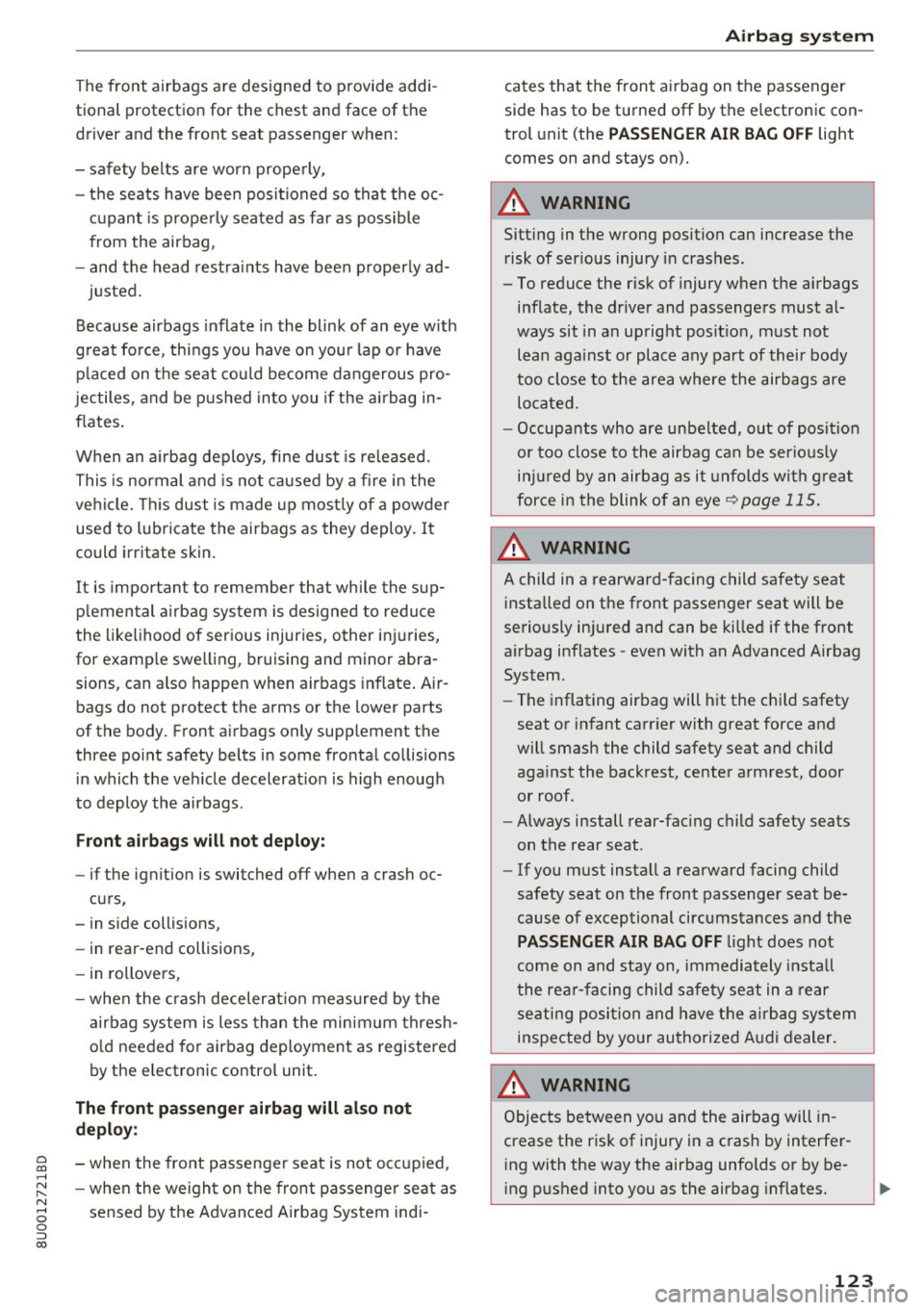
0 co ......
"' ,....
"' ...... 0 0 :::,
00
The front airbags are designed to provide addi
tional protection for the chest and face of the
driver and the front seat passenger when:
- sa fety belts are worn prope rly,
- the seats have been positioned so that the oc-
c u pant is properly sea ted as far as possible
from the airbag,
- and the head restra ints have been p roperly ad-
justed.
Because airbags inflate in the blink of an eye w ith
g reat fo rce, things you have on your lap or have
p laced on the seat cou ld become dangerous pro
jectiles, and be p ushed into you if the ai rbag in
flates.
When an a irbag deploys, fine dust is released.
This is normal and is not caused by a fire in the
ve hicl e. Thi s dust is made up mostly of a powder
used to lubricate the airbags as they deploy. It
could irritate skin.
It is important to remember that whi le the sup
p lemental airbag system is designed to reduce
the likel ihood of ser ious injuries, other i nju ries,
for example swelling, bruising and minor abra
sions, can a lso happen when airbags inflate . Air
bags do not protect the arms or the lower parts
of the body. Front airbags only supplement the
three po int safety belts in some frontal collisions
i n which the ve hicle decelerat io n is high enough
to deploy the airbags .
F ront airbag s will not deploy:
- if the ignit ion is switched off when a crash oc-
curs,
- in side collisions,
- in rear-end collisions,
- in rollove rs,
- when the c rash decelerat io n meas ured by the
airbag system is less than the minimum thresh
o ld needed for airbag deployment as registered
by the electronic contro l unit.
The front passenger airbag will also not d eplo y:
- when the front passenger seat is not occ upied,
- when the we igh t on the fron t passenge r seat as
sensed by t he Advanced A irbag System indi-
Airb ag sys tem
cates that the front a irbag on the passenger
side has to be turned off by the e lectronic con
trol unit (the
PASSENGER AIR BAG OFF light
comes on and stays on).
A WARNING
Sitting in the wrong position can increase the r isk of ser ious injury in crashes .
- To reduce the r isk of injury when the airbags
inflate, the driver and passengers must al
ways sit in an upright posit ion, must not
lean aga inst or place any part of their body
too close to the area where the airbags are
lo cated.
- Occupants who are unbelted, out of posit ion
or too close to the airbag can be serio usly
in jur ed by an airbag as it unfolds with g reat
force in the blink of an eye
r=> page 115.
A WARNING
-A child in a rearward-facing child safety seat
insta lled on the front passenger seat will be
seriously injured and can be ki lled if the front
airbag inflates -even with an Advanced Airbag
System.
- The inflating airbag will h it the ch ild safety
seat or in fant carr ier with great force and
will smash the child safety seat and child aga inst the backrest, center armrest, door
or roof.
- Always install rear-fac ing child safety seats
on the rear seat.
- If you must install a rearward facing child
safety seat on the front passenger seat be
cause of exceptional circumstances and the
PASSENGER AIR BAG OFF light does not
come on and stay on, immedia tely insta ll
the rea r-facing child safety se at in a rear
seating posi tion and have the airbag system
inspected by your au thorized Audi dealer.
A WARNING
= -
Objects between you and the airbag will in -
crease the risk of injury in a crash by interfer
i ng with the way the airbag unfolds or by be
i ng p ushed into you as the airbag inflates.
123
Page 221 of 230
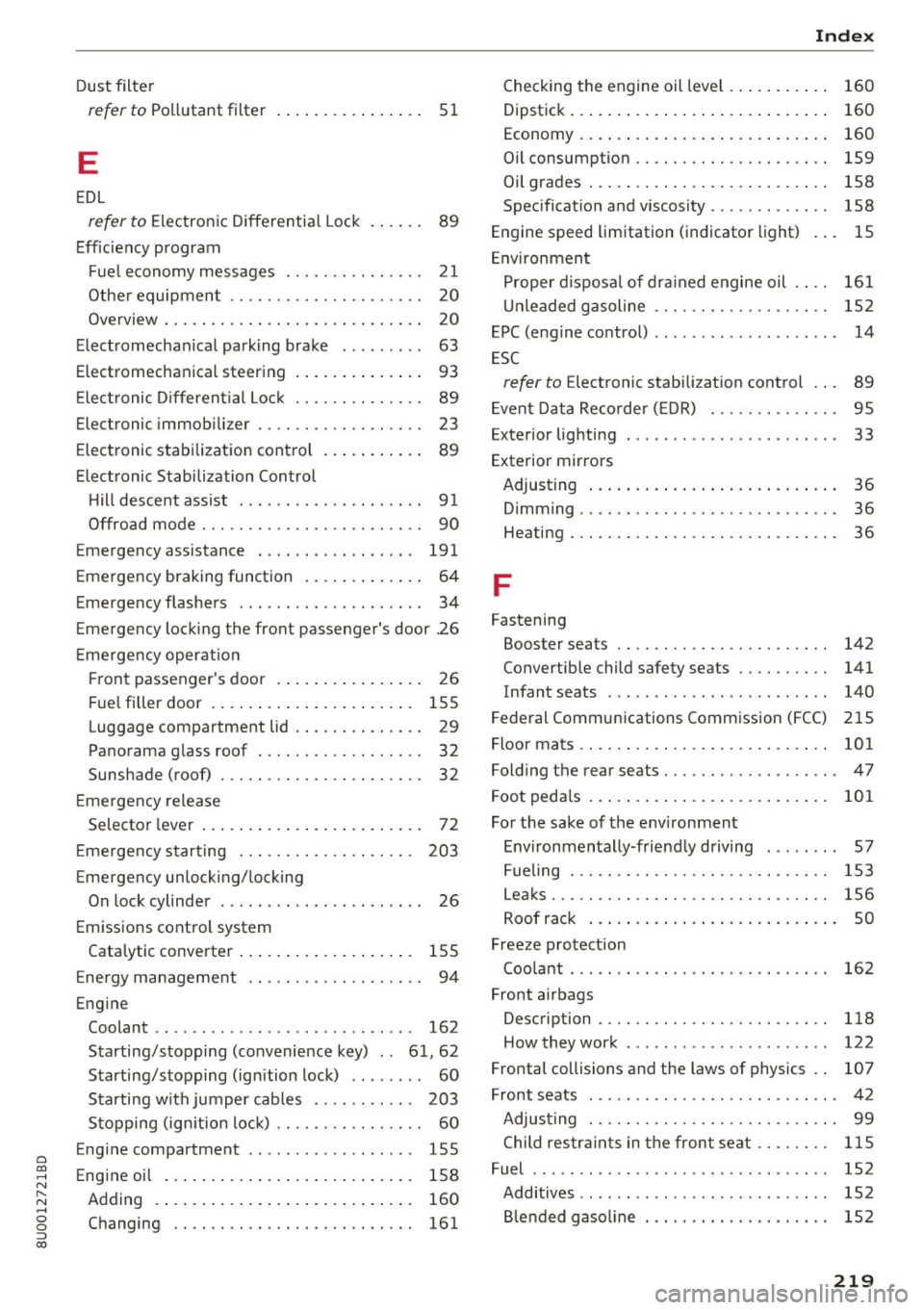
0 co ......
"' ,....
"' ...... 0 0 :::,
00
Dust filter
refer to Pollutant filter . . . . . . . . . . . . . . . . S 1
E
EDL
refer to Electronic Differential Lock . . . . . . 89
Efficiency program
Fuel economy messages . . . . . . . . . . . . . . .
21
Other equipment . . . . . . . . . . . . . . . . . . . . . 20
Overview . . . . . . . . . . . . . . . . . . . . . . . . . . . . 20
Electromechanical parking brake . . . . . . . . . 63
Electromechanical steering . . . . . . . . . . . . . . 93
E lectronic Differential Lock . . . . . . . . . . . . . .
89
Electronic immobilizer . . . . . . . . . . . . . . . . . . 23
Electronic stabilization control . . . . . . . . . . .
89
Electronic Stabilization Control
Hill descent assist . . . . . . . . . . . . . . . . . . . .
91
Offroad mode . . . . . . . . . . . . . . . . . . . . . . . . 90
Emergency assistance . . . . . . . . . . . . . . . . . 191
Emergency braking function . . . . . . . . . . . . . 64
Emergency flashers . . . . . . . . . . . . . . . . . . . . 34
Emergency locking the front passenger's door .26
Emergency operation
Front passenger's door . . . . . . . . . . . . . . . .
26
Fuel filler door . . . . . . . . . . . . . . . . . . . . . . 155
Luggage compartment lid . . . . . . . . . . . . . . 29
Panorama glass roof . . . . . . . . . . . . . . . . . . 32
Sunshade (roof) . . . . . . . . . . . . . . . . . . . . . . 32
Emergency release
Selector lever . . . . . . . . . . . . . . . . . . . . . . . .
72
E mergency starting . . . . . . . . . . . . . . . . . . . 203
Emergency unlocking/locking
On lock cylinder . . . . . . . . . . . . . . . . . . . . . .
26
Emissions control system
Catalytic converter . . . . . . . . . . . . . . . . . . .
155
Energy management . . . . . . . . . . . . . . . . . . . 94
Engine
Coolant . . . . . . . . . . . . . . . . . . . . . . . . . . . .
162
Starting/stopping (convenience key) . . 61, 62
Starting/stopping (ignition lock) . . . . . . . . 60
Starting with jumper cables . . . . . . . . . . . 203
Stopping (ign ition lock) . . . . . . . . . . . . . . . .
60
Engine compartment . . . . . . . . . . . . . . . . . . 155
Engine oil . . . . . . . . . . . . . . . . . . . . . . . . . . . 158
Adding . . . . . . . . . . . . . . . . . . . . . . . . . . . . 160
Changing . . . . . . . . . . . . . . . . . . . . . . . . . . 161
Index
Checking the engine oil level . . . . . . . . . . . 160
Dipstick . . . . . . . . . . . . . . . . . . . . . . . . . . . . 160
Economy... ... .. .. ................. 160
Oil consumption . . . . . . . . . . . . . . . . . . . . . 159
Oil grades . . . . . . . . . . . . . . . . . . . . . . . . . . 158
Specification and viscosity . . . . . . . . . . . . . 158
Engine speed limitation (indicator light) 15
Environment
Proper disposal of drained engine oil . . . .
161
Unleaded gasoline . . . . . . . . . . . . . . . . . . . 152
EPC (engine control) . . . . . . . . . . . . . . . . . . . . 14
ESC
refer to Electronic stabilization control . . . 89
Event Data Recorder (EDR) . . . . . . . . . . . . . . 95
Exterior lighting
33
Exterior mirrors Adjusting . . . . . . . . . . . . . . . . . . . . . . . . . . . 36
D. . 1mm1ng .. .. .. .. .. ............... .. . 36
Heating . . . . . . . . . . . . . . . . . . . . . . . . . . . . . 36
F
Fastening
Booster seats . . . . . . . . . . . . . . . . . . . . . . .
142
Convertible child safety seats . . . . . . . . . . 141
Infant seats . . . . . . . . . . . . . . . . . . . . . . . . 140
Federal Communications Commission (FCC) 215
Floor mats . . . . . . . . . . . . . . . . . . . . . . . . . . . 101
Folding the rear seats. . . . . . . . . . . . . . . . . . . 47
Foot pedals . . . . . . . . . . . . . . . . . . . . . . . . . . 101
For the sake of the environment
Environmentally-friendly driving . . . . . . . .
57
Fueling . . . . . . . . . . . . . . . . . . . . . . . . . . . . 153
Leaks. . . . . . . . . . . . . . . . . . . . . . . . . . . . . . 156
Roof rack . . . . . . . . . . . . . . . . . . . . . . . . . . . SO
Freeze protection Coo lant . . . . . . . . . . . . . . . . . . . . . . . . . . . .
162
Front airbags
Description . . . . . . . . . . . . . . . . . . . . . . . . .
118
How they work . . . . . . . . . . . . . . . . . . . . . . 122
Frontal collisions and the laws of physics . . 107
Front seats . . . . . . . . . . . . . . . . . . . . . . . . . . . 42
Adjusting . . . . . . . . . . . . . . . . . . . . . . . . . . . 99
Child restraints in the front seat ...... . .
Fuel
. . ...... ... .. .. ... ....... ... .. . .
115
152
Additives . . . . . . . . . . . . . . . . . . . . . . . . . . . 152
Blended gasoline . . . . . . . . . . . . . . . . . . . . 152
219
Page 225 of 230
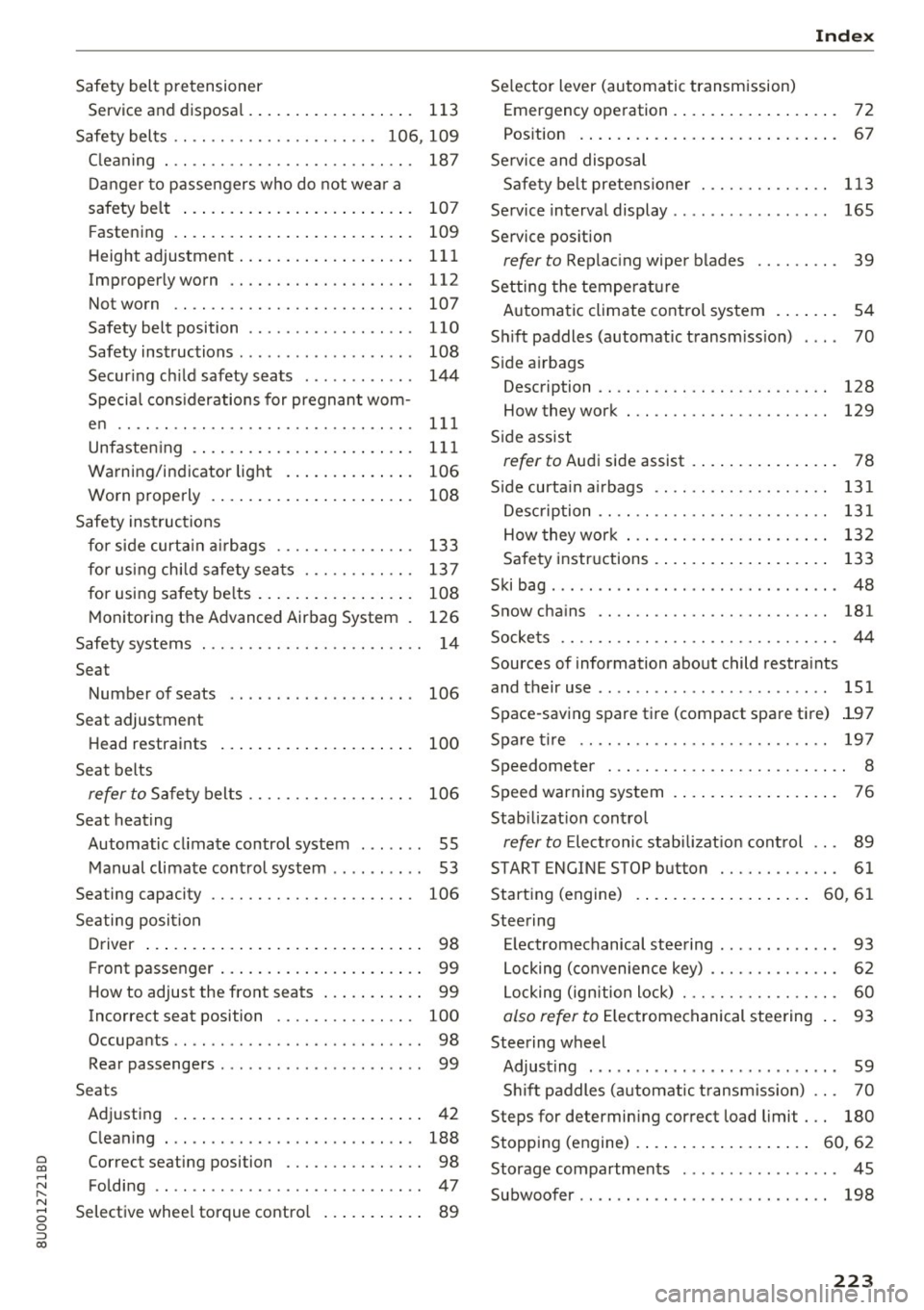
Safety belt pretensioner Service and disposa l............ ..... . 113
Safety belts . . . . . . . . . . . . . . . . . . . . . . 106, 109
C leaning . . . . . . . . . . . . . . . . . . . . . . . . . . . 187
Danger to passengers who do not wear a
safety belt . . . . . . . . . . . . . . . . . . . . . . . . . 107
Fastening . . . . . . . . . . . . . . . . . . . . . . . . . . 109
H eight adjustment . . . . . . . . . . . . . . . . . . . 111
Improperly worn ............. .. ..... 112
Not worn . . . . . . . . . . . . . . . . . . . . . . . . . . 107
Safety belt position . . . . . . . . . . . . . . . . . . 110
Safety instructions . . . . . . . . . . . . . . . . . . . 108
Securing child safety seats . . . . . . . . . . . . 144
Special considerations for pregnant wom-
en . . . . . . . . . . . . . . . . . . . . . . . . . . . . . . . . 111
Unfastening . . . . . . . . . . . . . . . . . . . . . . . . 111
Warning/indicator light . . . . . . . . . . . . . . 106
Worn properly . . . . . . . . . . . . . . . . . . . . . . 108
Safety instructions
for side curta in a irbags . . . . . . . . . . . . . . . 133
for using ch ild safety seats . . . . . . . . . . . . 137
for using safety be lts . . . . . . . . . . . . . . . . . 108
Monitoring the Advanced Airbag System . 126
Safety systems . . . . . . . . . . . . . . . . . . . . . . . . 14
Seat Number of seats
Seat adjustment 106
Head restraints . . . . . . . . . . . . . . . . . . . . . 100
Seat belts
refer to Safety belts . . . . . . . . . . . . . . . . . . 106
Seat heating Automatic climate control system . . . . . . . 55
Manual climate control system . . . . . . . . . . 53
Seating capacity . . . . . . . . . . . . . . . . . . . . . . 106
Seating position Driver . . . . . . . . . . . . . . . . . . . . . . . . . . . . . . 98
Fr ont passenger . . . . . . . . . . . . . . . . . . . . . .
99
How to adjust the front seats . . . . . . . . . . . 99
Incorrect seat position . . . . . . . . . . . . . . . 100
Occupants . . . . . . . . . . . . . . . . . . . . . . . . . . . 98
Rear passengers . . . . . . . . . . . . . . . . . . . . . .
99
Seats
Adjusting . . . . . . . . . . . . . . . . . . . . . . . . . . . 42
Cleaning . . . . . . . . . . . . . . . . . . . . . . . . . . . 188
~ Correct seating position . . . . . . . . . . . . . . . 98 ......
~ Folding . . . . . . . . . . . . . . . . . . . . . . . . . . . . . 47
N
8 Selective whee l torque contro l . . . . . . . . . . . 89
0
:::,
00
Index
Se lector lever (automatic transmission)
Emergency operation . . . . . . . . . . . . . . . . . . 72
Pos ition . . . . . . . . . . . . . . . . . . . . . . . . . . . . 67
Service and disposal Safety belt pretensioner . . . . . . . . . . . . . . 113
Service interval display . . . . . . . . . . . . . . . . . 165
Service position
refer to Replacing wiper blades . . . . . . . . . 39
Setting the temperature
Automatic climate cont rol system . . . . . . . 54
Sh ift paddles (automatic transm iss ion) . . . . 70
Side airbags Description . . . . . . . . . . . . . . . . . . . . . . . . . 128
How they work . . . . . . . . . . . . . . . . . . . . . . 129
Side assist
refer to Audi side assist . . . . . . . . . . . . . . . . 78
S ide curta in airbags . . . . . . . . . . . . . . . . . . . 131
Description . . . . . . . . . . . . . . . . . . . . . . . . . 131
How they work . . . . . . . . . . . . . . . . . . . . . . 132
Safety instructions . . . . . . . . . . . . . . . . . . . 133
Ski bag. ........... .... ........... .... 48
Snow chains . . . . . . . . . . . . . . . . . . . . . . . . . 181
Sockets . . . . . . . . . . . . . . . . . . . . . . . . . . . . . . 44
Sources of information about child restraints
and their use . . . . . . . . . . . . . . . . . . . . . . . . . 151
Space-saving spare tire (compact spare tire)
. 197
Spare tire . . . . . . . . . . . . . . . . . . . . . . . . . . . 197
Speedometer . . . . . . . . . . . . . . . . . . . . . . . . . . 8
Speed warning system . . . . . . . . . . . . . . . . . . 76
Stab ilization control
refer to E lectronic stabi lization control . . . 89
START ENGINE STOP button . . . . . . . . . . . . . 61
Starting (engine) . . . . . . . . . . . . . . . . . . . 60, 61
Steering Electromechanical steering . . . . . . . . . . . . . 93
Locking (convenience key) . . . . . . . . . . . . . . 62
Locking (ignition lock) . . . . . . . . . . . . . . . . . 60
also refer to Electromechanical steering 93
Steering wheel Adjusting . . . . . . . . . . . . . . . . . . . . . . . . . . . 59
Shift paddles (automatic transmiss ion) . . . 70
Steps for determining correct load limit . . . 180
Stopping (engine) . . . . . . . . . . . . . . . . . . . 60, 62
Storage compartments . . . . . . . . . . . . . . . . . 45
Subwoofer. . . . . . . . . . . . . . . . . . . . . . . . . . . 198
223